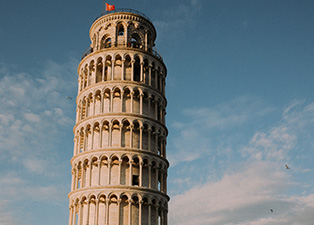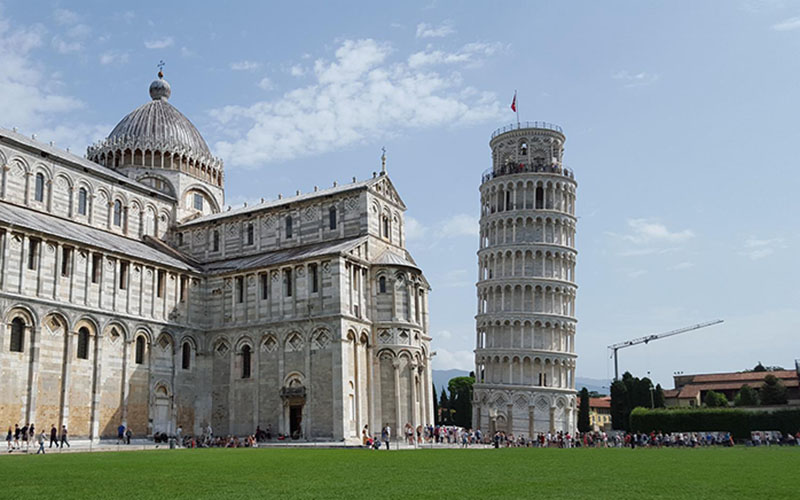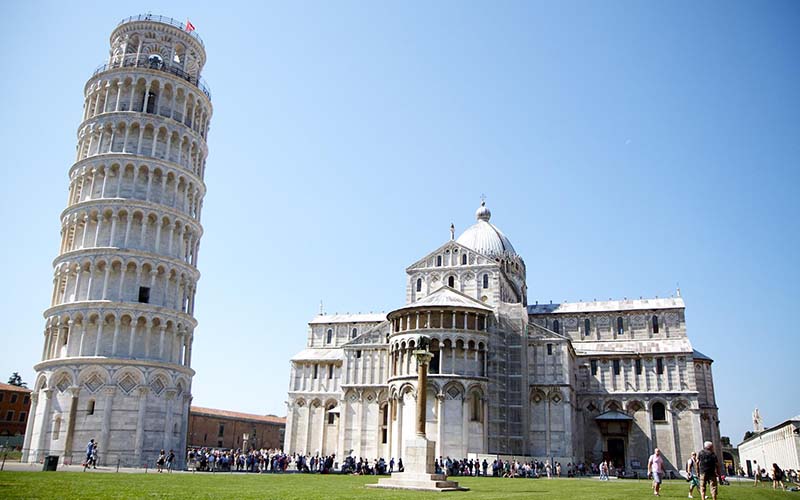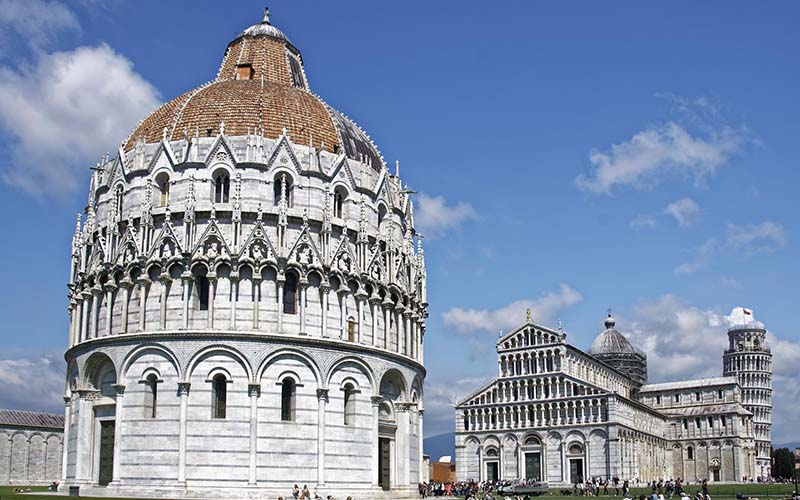The renowned Leaning Tower of Pisa was constructed in the 13th century. It can be found in the city of Pisa (pronounced peez-ah, not pizza), which is situated in the northern part of Tuscany, about 80 kilometers west of Florence. The tower, famous for leaning to one side, is one of Italy’s most popular tourist destinations. It brings in millions of travel enthusiasts every year, fascinated by its intricate architecture, even though it was unsuccessful.
On the Piazza del Duomo, or as it is more frequently known, the Campo Dei Miracoli, you will discover the Leaning Tower of Pisa, the cathedral, and the baptistery of Pisa (field of miracles).
The history of the tower that leans to one side
Its construction on the campanile, also known as the bell tower of the Cathedral of Milan, began in the 12th century. Along with the other three buildings on the site, the tower, which is made of white marble and has the shape of a cylinder, is covered with geometric patterns inspired by Arabic design. It is often regarded as one of the most impressive examples of Romanesque architecture in all of Tuscany.
The tower’s construction took almost two hundred years, but the building had already begun to tilt long before the very final stone was set. Even before the builders had finished the tower’s third floor, it had already started to lean to one side since the foundation was not strong enough and the ground underneath was too soft. The architects who designed the tower in the 13th century built subsequent floors taller on one side than the other to make up for the tilting and uneven weight distribution. As a result, the tower has a slight curve to it. Despite this, it continued to tilt to the side at a pace of almost two millimeters each year for the next 800 years until the big bells were taken off of it and secured into the ground. Engineers determined that the tower is secure and stable today and reported that it has stopped moving altogether.
Suggested Read: The Best Places and Cities to Visit in Italy
Activities Available at the Campo Dei Miracoli and the Tower of Pisa
Climb the tower to the top. Your trip up the winding staircase, which has a total of 297 steps, will commence once a staff member provide you with an overview of the tower’s history and some interesting trivia. The building stands at 184 feet (56 meters) and contains eight stories. Six of the levels are open galleries, allowing visitors to enjoy magnificent vistas of the city as well as the landscape in the surrounding area.
Pay a visit to the cathedral and the museum. The outside of the Duomo is quite impressive with its remarkable four-tiered front, white colonnades, and arcades. Additionally, the Duomo has spectacular bronze-paneled doors with bas-relief casts by Bonanno Pisano. The entrance to the Portale di San Ranieri is particularly stunning. A magnificent mosaic of Christ in Majesty can be seen in the cathedral’s apse. The apse also has a marble pulpit from the 14th century that was sculpted out of marble. You will find here the tomb of Henry VII (of the Holy Roman Empire).
The Museo dell Opera del Duomo, also known as the Museum of Cathedral Works, can be found on the eastern side of the plaza in the building that once served as the cathedral’s charterhouse. In addition to paintings, Roman and Etruscan artifacts, and religious treasures, its collections feature artifacts removed from the Cathedral, the Baptistery, and the Camposanto.
Enter the Baptistry on the first floor (Battistero). The construction of the circular baptistery began in 1152. Still, it took several centuries to finish, mainly when Pisa was at war with neighboring city-states such as Florence and Siena. This was due to a periodic lack of funding. The remarkable acoustics of the baptistery is one of the reasons for its magnificent Gothic architecture and construction. Crouching lions, considered to symbolize olizees, are carved into the pillars supporting the hexagonal pulpit. The octagonal font made of marble and inlaid wood was designed by Guido da Como and installed in 1246.
The carved pulpit reliefs by Nicola and Giovanni Pisano, which can be found inside the baptistery, portray many biblical scenes, such as the Adoration of the Magi, the Crucifixion of Christ, the Last Judgment, and the Nativity. These are only a few of the scenes that can be seen. Take note of the white and gray striping that can be found inside the cathedral; this is a frequent design that can be found in other Italian churches built around the same period, most notably those in Siena and Orvieto.
Proceed to circumambulate the Camposanto (cemetery). A trip to the Camposanto, often known as the graveyard, is highly recommended even though tourists frequently skip through it. The extended structure features a grassy center plaza. It is surrounded by covered arcades crammed with tombstones and other burial monuments belonging to Pisa’s Renaissance nobility. Most medieval frescoes and Roman antiquities housed in the portico before World War II were obliterated or severely damaged.
Visit the Sinopie Museum. This museum, located in what was formerly a hospital, is home to the sinopias, also known as the original parchment designs used to create the paintings in the Camposanto. These sketches were discovered on the walls behind the murals after the Camposanto suffered damage during World War II, and the murals were substantially destroyed. They were taken care of and saved.
Check Also: Tips for Perfect One Day in Milan Itinerary 2025
How to make your Trip to the Campo dei Miracoli memorable?
Location: Campo dei Miracoli, 56100 Pisa, Italy
The entrance fee for the Tower is 18 Euros, and reservations can be made on the official website of the Campo Dei Miracoli attractions up to 20 days in advance. The entrance fee to the Duomo is never collected from visitors. The prices to visit the other museums and monuments are as follows: €5 for one, €7 for two, and €8 for three. These prices are based on the number of museums and monuments you intend to visit.
It is important to note that admission tickets for the Leaning Tower must always be acquired in advance. Because of the restricted number of attendees and the timed tickets, it is pretty doubtful that you will be able to go up on the spot and purchase a ticket for the same day.
Hours: Campo dei Miracoli: Open daily. Closed on January 1 and the 25th of each month. Baptistry: Open daily 8 am-8 pm; The Camposanto (cemetery): Open daily 8 am-10 pm; Tower: Open daily 8 am-8 pm (hours may change according to special events); Duomo: Open daily 10 am-8 pm (open only in the afternoons on Sundays);
Please note that admission to all buildings is complimentary for guests with disabilities, one companion, and children younger than ten years old.
Local Points of Interest
The Orto Botanico is one of the oldest botanical gardens in Europe. It is also a wonderful place to spend some time because it is not very busy.
Piazza delle Cavalieri is on the north side of Pisa’s Palazzo dei Cavalieri. It was formerly the headquarters of the Cavalieri di Stanto Stefano, where it got its name; nevertheless, it is now the home of one of the most prominent institutions in Italy.




